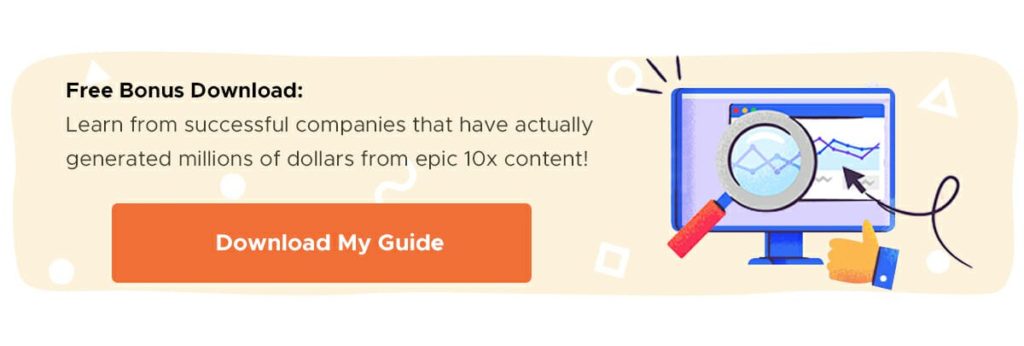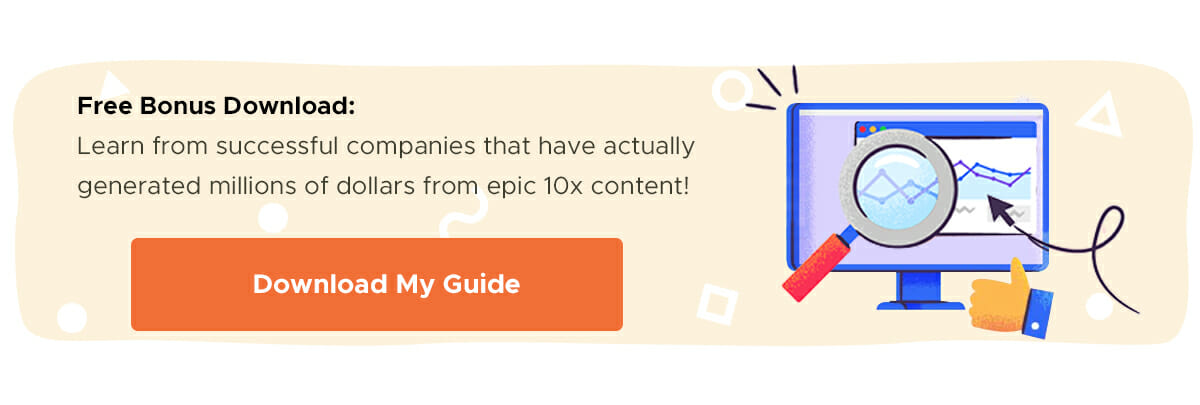Ranking #1 for important keywords on Google is a goal for most marketers and business owners, but I think you should go bigger than the top spot alone. Why? Because there’s a lot of real estate on that page besides the first ranking, and you should be taking full advantage of it.
Imagine this: You’re in the business of providing financial services to small companies. Of course you want to rank #1 for “financial services for small businesses.” But why not try to rank #1 and #2? The more you control on the page, the more you push your competitors to page two. It’s possible — I’ve done it.
In this post, I’ll tell you a few ways you can control page 1 of Google, not just rank on it.
Focus on Ranking Zero
For better or worse, featured snippets are taking over Google search results. If you occupy the snippet — or answer box — it’s called ranking zero.
For example, if you write an article that answers the question “What is work-life balance?” in a way that makes Google’s algorithm happy, then you might land the spot at the top where your answer appears before the links to other results:
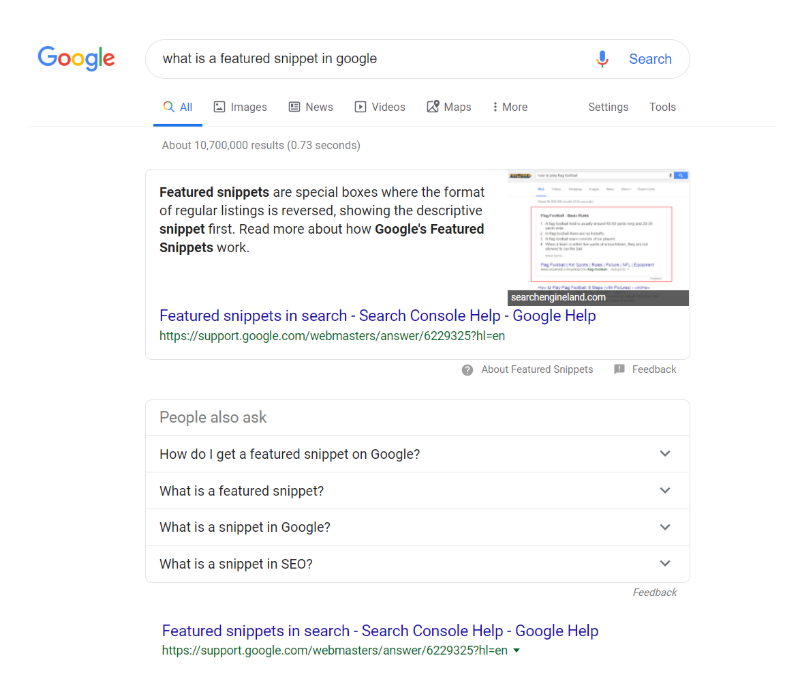
Here’s how to do this. First, focus on long-tail keywords. Make sure your title tags and headers (H1, H2, etc.) ask the exact question as the keyword search, and then answer it succinctly in paragraph form. The average paragraph length in a featured snippet is 40-60 words.
An added bonus of occupying the featured snippet is that your link will also appear in the list of search results on that page, giving you two of the top spots on page one.
Dive Deeper: Why You Should Use Long-Tail Keywords in Your SEO Campaign
Publish Similar Content in More than One Place
The more places you can put your content on a given subject, the higher you’ll rank for it. This doesn’t mean just creating a second website and republishing all your content on it, though. You have to be strategic about it.
Consider Creating Multiple Sites
This is a pretty labor-intensive option, but it can be effective. For example, Neil Patel has content on his own site and also on QuickSprout, a company he founded in 2008. Even though he isn’t part of the company anymore, he still has bylines on tons of articles. So when someone searches for a topic that Neil has written about on both sites, both links will come up on page one because they’re both considered authoritative sites for those keywords.
Owning and maintaining more than one site can be a lot of work, obviously, but you don’t have to fully own where you publish. Social media is another great way to push content out there. Posting articles on LinkedIn, or even long snippets on Facebook with links back to the original content, will help you to boost your rank.
Become a Prolific Guest Poster
If you want your business to rank higher for certain keywords, write about them for websites that are more high-profile than yours, while also writing about them for your own site. The content on the higher-authority links will rank higher, but you’ll also get links back to your website through your bio and possibly within the article or post body content as well.
When Buffer co-founder Leo Widrich was trying to grow the company, he became an author on a ton of different sites, including Fast Company, Entrepreneur and Huffington Post:
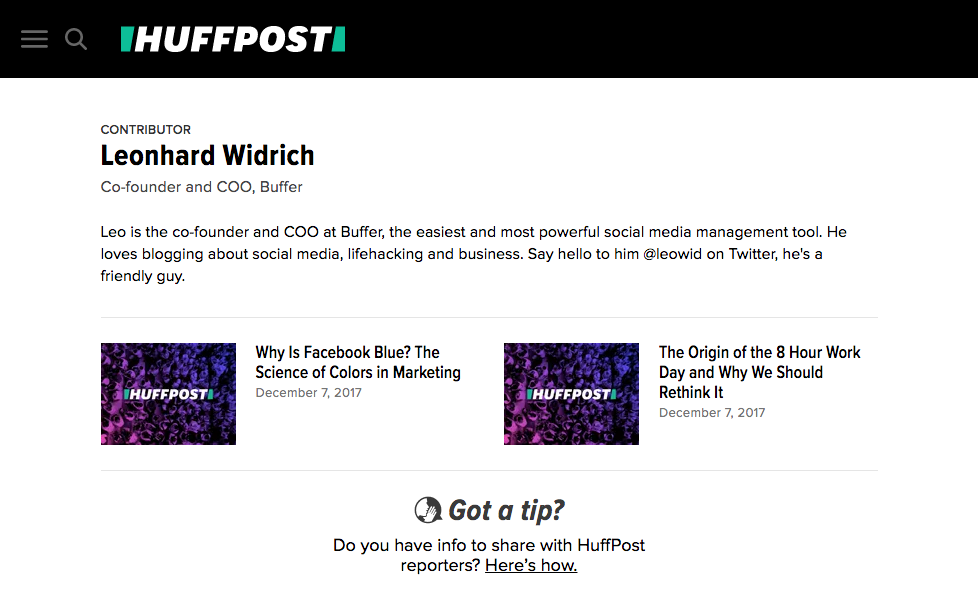
He didn’t do it for backlinks or Google rankings. He was just writing articles related to social media marketing. As people started Googling keywords related to the topic, they’d see his articles because the sites he wrote for ranked high for those keywords.
This worked well because in these articles he was promoting Buffer. The articles weren’t specifically about his company, but he mentioned it within them. Guest posting is a really good strategy rather than trying to maintain more than one site. Instead you’re leveraging other people’s keyword authority.
Replicate (but Don’t Duplicate) Content
Whether you’re posting content on multiple sites that you own, on social media or as a guest poster, it’s important not to publish the exact same content. Google doesn’t like duplicate content and will penalize you by demoting you in search rankings for it.
Even if it’s on the same exact topic, at least change the title, headers and some of the wording. Or branch out from one keyword into a few different topics.
For example, let’s say you’re trying to go after the term “SEO” or “online marketing.” You could create multiple pages of content hitting those keywords. One could be on “Online marketing for beginners.” Another one could be “Online marketing tools.” Yet another could be “The advanced guide to online marketing.” You could even do a piece called “Top 101 online marketing conferences that you have to attend.” The list goes on and on.
Once you have the important keywords defined for your business, you can keep creating content around them. The more content you have on a given subject, the more likely you are to rank for it.
Dive Deeper:
Cross-Link Your Content
You’ll never see a blog post on Single Grain that doesn’t link out to related content. You know why? Because Google likes internal links. Not as much as inbound links, but the search giant still likes them.
Links within your site help Google’s algorithm to better understand the structure and flow of your content and assess the overall value of that content:
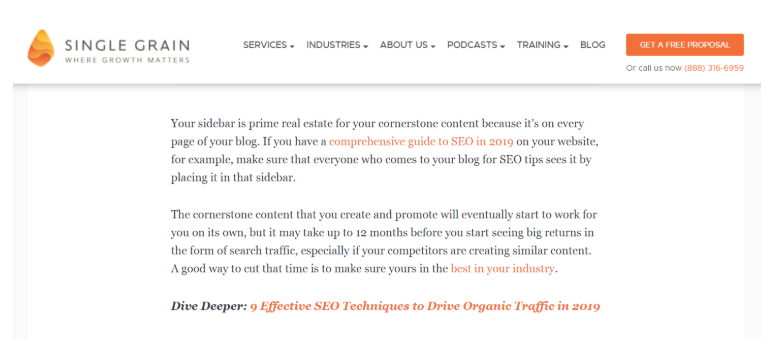
You can do cross-linking in one of two ways: linking individual words and phrases to related content, or specifically calling out a list of related content. We do both.
Pay Attention to Your Headlines
There’s an old statistic that still gets thrown around a lot: eight out of 10 people will read your headline, but only two out of 10 people will click through to read the content. I’d bet that, in the 10+ years since Copyblogger published that metric, the numbers have gotten even worse. So you really need to write headlines that get clicks.
The best headlines clearly define what the content is about, demonstrate the benefit of reading it and include strong adjectives and verbs. They also have to be SEO-friendly (it’s a tall order!).
The types of headlines that do really well are the ones that include these words:

The best way to discover the types of headlines that work best for your audience is to A/B test them. Buzzfeed achieved its early success largely through testing headlines, and continues to do so.
Using a tool like ClickFlow (full disclosure: it’s my tool) to test not just headlines, but entire pages and groups of pages will help you best optimize your content for improved SEO.
Dive Deeper: How to Write Hero Headlines to Skyrocket Click-Through Rates
Don’t Forget Your Title Tags
A huge SEO mistake I see a lot of people make is assuming that the title of their content and their title tag should be the same. This isn’t always the case. Here are some things to watch out for:
- Title tag length: Google cuts off titles at around 60 characters, so if your headline is “You’ll never believe this crazy hack I tried that completely transformed my company culture for the better,” you might want to shorten your title tag to something like “The crazy hack that transformed our company culture.” Moz has a title tag preview tool:
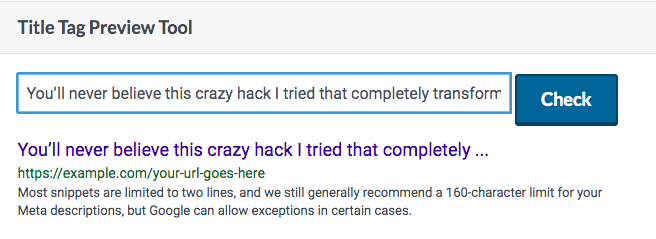
- Title tag keywords: Your keywords should go towards the beginning of your title tag. So if our keyword is “transform company culture” in the above example, we could update the title to: “How to transform company culture with one crazy hack.”
- Google may change your title tags: If Google finds issues with your title tags, they may dismiss them completely and pull content in from somewhere else to replace it. You can avoid this by making your titles descriptive, avoiding keyword stuffing and not repeating titles on site pages.
Your title tag is just as important as your headline, especially when it comes to Google rankings. Make sure yours are designed both to get clicks and also to follow the rules.
Dive Deeper: Absolutely Everything You Need to Know About 10x Content
Remember to Update Your Content
Another thing you can do if you really want to dominate the first page, is keep your content up-to-date. To rank higher, a lot of people just write the content, then forget it and call it a day. If you do this, you’ll notice that your pages will decrease in ranking.
Google wants to give people fresh content. If you keep yours updated regularly, you’ll notice that your rankings will do better over time (or at least remain steady). And if you have more than one piece of content on the same topic — and keep it updated — you can dominate the first page of search results.
Dive Deeper: 6 Ways Google Ads Can Boost Your SEO Results
Don’t Dismiss Google Ads
You’re probably reading this blog post so you can learn how not to spend money on Google Ads, but think about this: Say your content is in the featured snippet. That means it’s also in one of the top search results spots. Maybe you have a guest post on the same topic that made it to page one. And you were a cross-linking champion, so you ended up with a second link to content on the page.
Now imagine if you also threw in an ad. Most of the first page’s real estate will be yours.
If you really don’t want to spend money on the typical Google Ads — and I get it, it’s expensive — you can still do Remarketing Lists for Search Ads (RLSA). If someone’s visited your site and you want to target them for a keyword that you know gets a lot of volume and that you rank for, you can do that too.
The higher costs of RLSA are generally worth it because the leads are more qualified — they’ve already visited your site. And they allow you to occupy more real estate on Google’s first page, which will make you look like a much stronger personality or business.
Dive Deeper:
Go After Those Backlinks
There are probably websites out there linking to your competitors instead of you. And that increases their chances of getting valuable real estate on Google’s first page of search results.
If you use a tool like Ahrefs Link Intersect, you can see everyone who links to your competitors, but not to you:
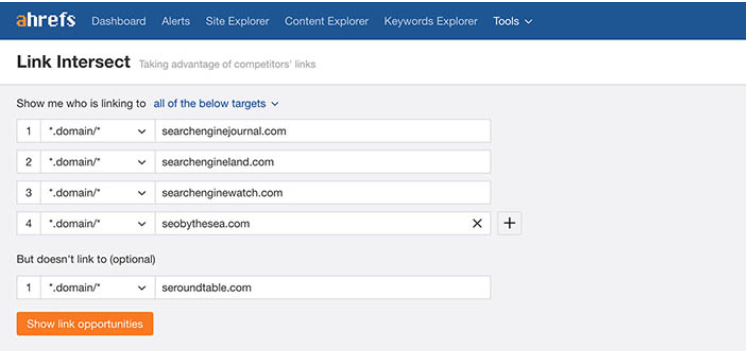
Then you can reach out to them with your up-to-date, fully optimized content and say, “Hey, I noticed you linked to X in this article about X. There have been many developments in X since that article was published, so I wanted to let you know that we just published an updated guide on it. Here’s the link if you think it would be of value to your readers.”
It won’t work every time, but when it does, it’ll help to increase your domain authority, which strongly influences the number of your links that show up on Google’s first page at the same time. You’ll end up occupying the best Google real estate because you have the best content that answers the questions that your current or potential customers have. Do that, and it’ll go a long way toward helping you dominate the first page of search results.
